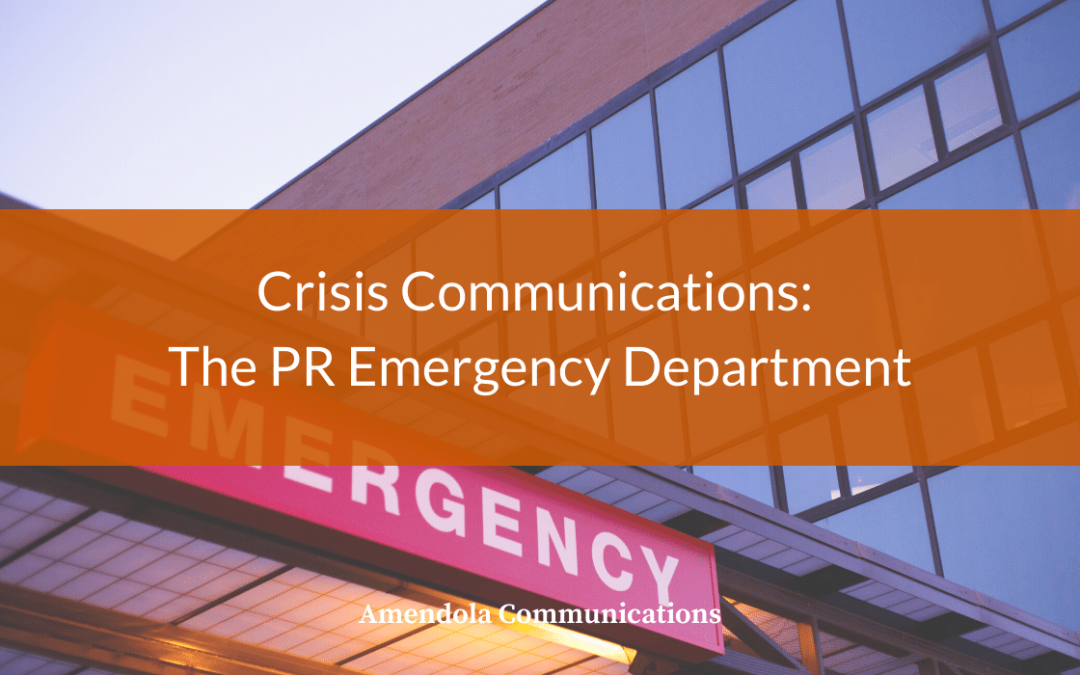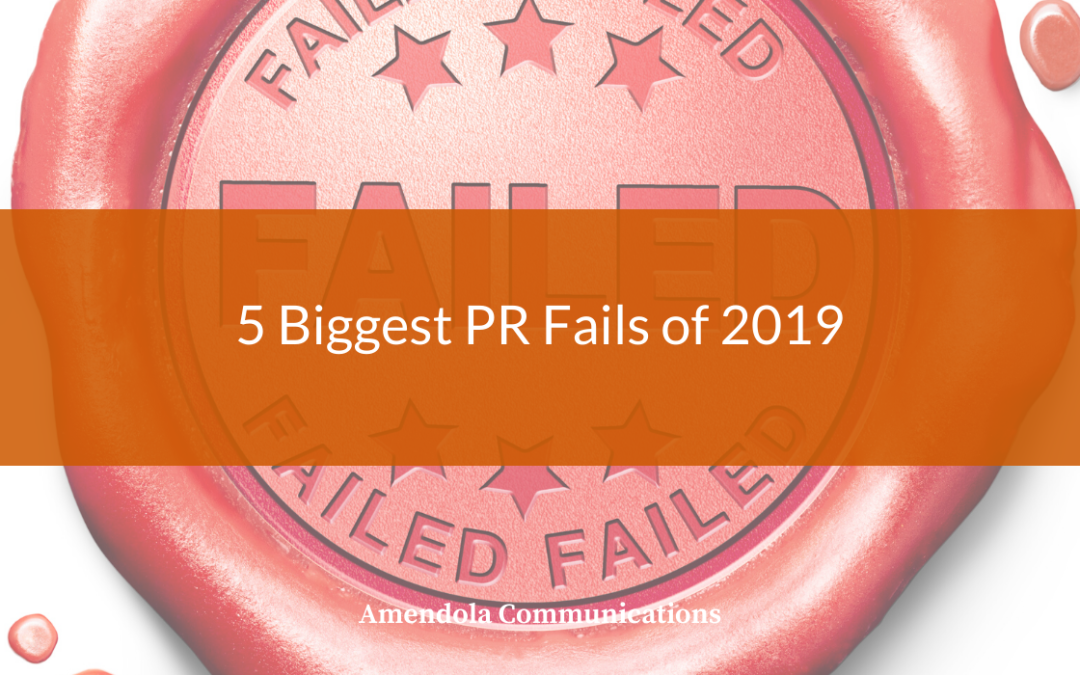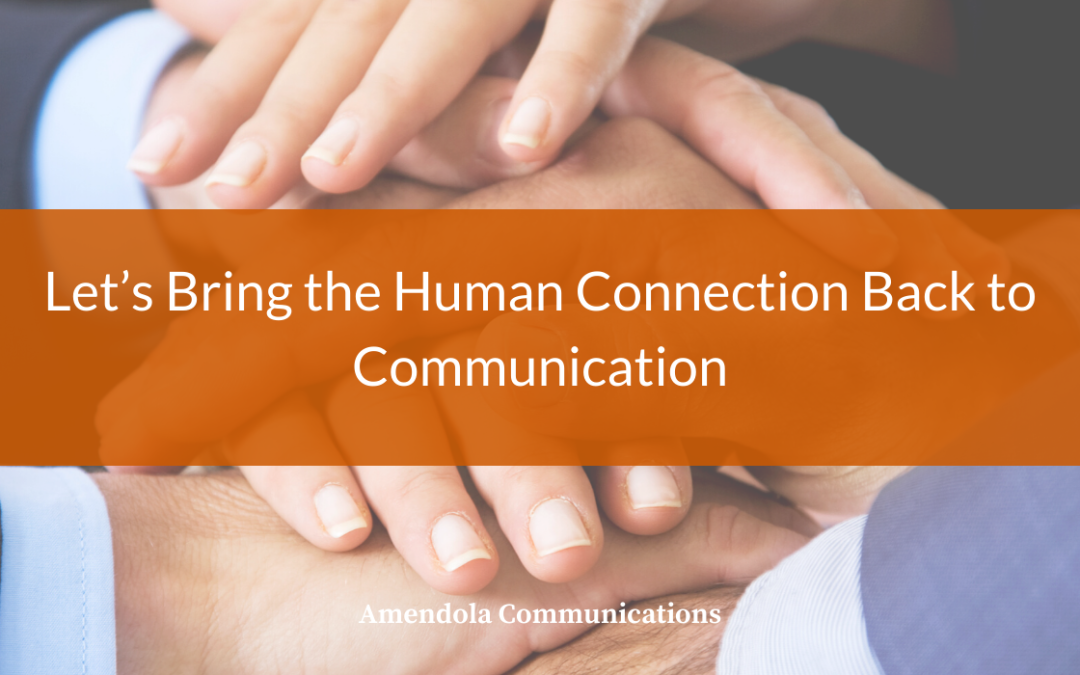
by admin | Feb 5, 2020 | Blog
You wake up and reach for your phone. Despite the many times you’ve heard it’s not healthy to check your email before your feet even hit the floor in the morning you immediately check your email.
This time, at the top of your inbox, is a message from your biggest client. It came through just after 6 a.m. At the top of the message is the first indication that your day is going to be interesting that good ol’ red “Urgent” exclamation mark.
The subject line reads “CALL ME ASAP.” You accept the fact that starting the coffee machine will have to wait awhile.
If you have been in PR for much time at all, some version of the above scenario has happened to you. The crisis could be any number of things.
In the healthcare industry, it could be a data breach that compromised thousands of electronic health records; a lawsuit; a massive bill from insurance; a disgruntled former employee spreading rumors on social media; or an important piece of medical equipment malfunctioning.
For nearly all enterprise organizations, and a good number of small to midsized business, a good PR firm is the first place they turn in the middle of a crisis. If you have done your job well as an agency, and earned the trust of your client, you are their emergency room in these situations. So you better have your scrubs on and your scalpel ready at all times.
When it comes to crisis communications, nothing is more important than having a solid predetermined plan in place. Before any sort of fire drill ever hits and the alarm starts blaring, the agency and the client should have had several proactive discussions during which they identified scenarios that might damage the brand or cast the company in a negative light. From there, messaging needs to be developed for each of those situations.
Of course, no one can anticipate every possible crisis. But if the most likely ones have been targeted, you can take your base messaging and create draft responses that are ready should one of those scenarios occur.
It likely won’t be the exact situation you planned for, but it will be close enough that you will only need to make tweaks and edits rather than developing your message from scratch in an already stressful situation. Better to hash out these responses over coffee and donuts when everyone is in a good mood, rather than at six in the morning when you haven’t even had the chance to brush your teeth, let alone get some caffeine into your bloodstream.
Once you have the messaging, you have a huge chunk of your prep work done. But it needs to be part of a larger plan that also includes:
A team leader from both the company and the agency
These two will be the main points of contact to keep leadership in the loop and field incoming calls from media to coordinate responses and/or interviews.
A spokesperson
It depends on the severity and level of attention the crisis has caused, but this should almost always be a C-level decision-maker whose name and voice carries the appropriate weight. This is the person who will give interviews and to whose name the statement will be attributed.
Internal communications
It is incredibly important that someone is assigned to internal communication to keep employees posted on the steps being taken during a crisis. There might be information that isn’t appropriate for you to share company-wide, but you need to share at least some details.
If not, staff will begin talking among themselves, to their families, and maybe even posting on social media. They can’t be in the dark.
On top of that, reporters might take some shots in the dark and start randomly reaching out to anyone who works for the company. If your staff hasn’t been told the plan, including that they should forward any media on to the company’s comms team, the problem can spin out of control fast. And once that happens, it’s nearly impossible to course-correct.
It might not be fun to imagine worst-case scenarios. It might even raise your heart rate. But once you do it, and your teams has a nice, neat folder saved on a shared drive somewhere with all the documents and procedures necessary for an organized response to an emergency, you will rest much easier.
You might even be able to pour a cup of coffee before you spend the rest of the day firing off emails and fielding phone calls.

by Morgan Lewis | Jan 29, 2020 | Blog
In our 24-hour news cycle increasingly driven by social media virality — public relations disasters occur and are crowded out so quickly that many people, including me, don’t even notice them. In 2019, there have been a few exceptions to that rule, which are listed below.
These companies and individuals didn’t just commit one PR blunder, but rather a sustained or repeated series of PR fails that withstood the shortening attention span of the news media and public. The biggest PR disasters in of 2019 include:
PR Fail #1: Boeing Appears Callous After Crashes
After crashes involving its 737 Max airplane in late 2018 that killed 189 people and in March 2019 that killed 157 people, Boeing continued to publicly insist that its planes were safe instead of recalling all the aircraft immediately and launching an investigation.
It didn’t help that a National Transportation Safety Board investigation revealed later that the aircraft’s new MCAS software was a contributor in both crashes or that whistleblowers emerged to allege the company cut corners to reduce costs and speed production while not documenting safety faults. Boeing continues to lose
orders from airliners and its stock price and revenue dropped precipitously throughout the year.
Boeing treated a major crisis involving the loss of hundreds of lives as if it were passengers complaining on social media about uncomfortable seats and lack of luggage space. Their response should have been contrite, swift and comprehensive.Heren gym T-shirt grijs bodybuilding trainingsshirt training ijzeren tanks proviron kopen tbol strikt als een pre-workout.
Even if human error was a factor in both crashes, such major catastrophic events involving the same airplane required the company to demonstrate that it was
doing everything possible to investigate and protect passengers. Instead, it denied anything was wrong and let public opinion take control.
PR Fail #2: Facebook – Here We Go Again
After a very rough 2016 presidential election where the social media giant was accused of enabling the spread of misinformation from fake accounts, it was revealed the site sold user data to Cambridge Analytica and other outside groups for political research. This led the company being ranked as the “least
trusted” tech company, according to a Fortune poll.
In 2019, even after Google and Twitter issued strict guidelines limiting political advertising, Facebook, as of this blog post, was still undecided about what it would do about the ads.
Its first public comments stated the site would do nothing in fairness to free speech, regardless of how false the claims were. Recently, a story leaked that Facebook might flag all ads as not fact-checked, which some pointed out would paint even well-cited ads with the same brush as those with fabrications.
Considering the hundreds of millions of dollars Facebook takes in from these and similar ads, it’s not surprising they are reluctant to push back, but the indecisiveness only ramps up the lack of integrity and untrustworthiness perception it has in the market.
PR Fail #3: College Admissions Scandal
Two famous TV actresses were implicated with at least 51 other parents in a scheme involving bribes and hired test-takers to help their children gain admission to prestigious colleges.
One would assume that the celebrities would have memorized and rehearsed a carefully worded script within 48 hours to perform before the news cameras. Instead, there was silence.
One of the actresses, Lori Laughlin, even signed autographs before a court appearance. The colleges involved in the scandal, namely Yale and UCLA,
were far more transparent about what they knew about the fraud committed by the parents’ hired conspirators and then revoked offers to the students involved,
which was a much better PR response to the crisis.
These institutions also have strong reputations that can withstand this tertiary involvement in such a scandal. I can assume the actresses’ legal teams urged them to remain silent. I would also bet their publicity teams had a crisis communications game plan ready, but they just weren’t allowed to execute it.
Regardless, in a society obsessed with celebrity, it seems like a missed opportunity by the actresses’ legal teams to sway the court of public opinion before the accused appeared in federal court.
PR Fail #4: IHOP Wearies the Market
In 2018, IHOP pretended to change its famous acronym to IHOb (for burgers), which, albeit quite intentionally, generated a news and social media storm. Depending on who you talk to, the stunt was either ill-advised because it was just a trick, or quite successful because it got people talking about and buying the restaurant’s burgers and it gained 60,000 Twitter followers.
After such a big response, IHOP went back to the well in 2019 to launch a new line of burgers with a marketing campaign that referred to them as “pancakes.” Get it?
Well, it didn’t generate quite as much news or social media attention as the fake rebranding and it just further confused the market. While more of a marketing misstep than PR, it does show how important brand trust is, even with tongue-in-cheek marketing.
After the name-change stunt and follow-up, what are consumers going to believe? Will they even bother paying attention to from the pancake-restaurant chain?
PR Fail #5: Uber is Lost
The PR and reputational struggles of the ride-sharing service continued in 2019.
After hiring a new CEO and its first chief marketing officer, the CMO and chief operating officer resigned and Uber laid off 400 marketing employees. This is despite a $500 million rebranding and reputation management effort launched after news media coverage of its toxic culture and driver underpayments emerged in 2017.
Unsurprisingly, the company’s stock price plummeted after its IPO in May 2019, although not solely related to its PR struggles. Not helping the reputational renewal was a report the company released in December 2019 showing nearly 6,000 reports of sexual assaults involving rides in the U.S. in 2017 and 2018.
The only positive aspect of this horrific PR moment is that Uber released the report itself, demonstrating some degree of transparency. Its top competitor, Lyft, which has its own similar problems, has yet to release such a report.
Bottom line
There is plenty to be learned about crisis communications and reputation management in these incidents and others, namely the importance of responding quickly, being transparent and controlling the narrative.
There are plenty of experts on such matters here at Amendola and you can read their insights here and here. Better yet, give us a call and our media relations and crisis management team can help you design a plan and keep your stress levels down and reputation up if such an incident occurs involving your organization.

by Chris Currington | Jan 22, 2020 | Blog
The first rule of real estate is “location, location, location.” Anyone who’s ever been in the market to buy or sell a home has been told this by a family member, friend or agent. But when you’re buying a house where exactly is the best location? The answer: It depends.
Truth told, there are many variables when you decide to buy a home, most notably price and cost. You may want to live in a certain location, but the price of the houses there may not fit your monthly mortgage budget. So you have to look for a different location.
Another example: let’s say you want to buy a house in a historical part of a city. The prices may be cheaper for the houses, but there may be a lot more maintenance and cost that goes into it.
In marketing, the question often arises, “how often should I be reaching out to my prospects so I can close a sale?” The answer here is the same as buying a house: It depends.
Some of the factors determining your approach to outreach are sales goals, clearing the shelves, price of the product and the length of the sale. The following are some points to keep in mind when determining how often you want to reach out to potential buyers based on your approach to the sales process.
The Hunting Approach to Sales and Frequency of Contact
In this approach to the sales process, the service or good could be a one-time acquisition or it could be purchased several times. When gaining leads, the company looks at the population of prospects, and then answers the question, “who am I going to go after?”
Next, they determine the outreach approach based on the “target’s” buying journey and how they gain information. And then they hunt.
With this approach, what one hopes to achieve is an initial buy and then the possibility of repeat customers. Because of this, they need to determine how often to reach out and provide prospects with pertinent information to get them to buy. This approach may be applicable to both business-to-business (think Dunder-Mifflin) and business-to-consumer relationships.
Groupon is a good example. If you’ve ever given your personal email address to Groupon, you’ll soon find that emails show up as frequently as daily. And there’s a reason. It’s because the sales and buying opportunities change daily, and the buyer has to act fast or could miss out on the deal.
Another example is if you have an Amazon Prime account. Emails show up almost daily, because the discounts and shipping options change daily as well.
But what about other sales and discounts that don’t change as frequently? In this instance, too many emails can sometimes be annoying because the offering isn’t necessarily changing that often.
In these instances, it’s important to assess when the amount of outreach becomes an annoyance. What you want to avoid is prospects hitting the “unsubscribe” button and losing their business or never getting it in the first place.
Examples of companies that may reach out too often are online meal kit delivery services, movie theaters and car rental companies. The questions to answer here are: is the meal kit option changing in the next month, do I need to rent a car this week, and are the movies switching out today? If the answer is, “probably not” then it’s important to watch how often emails are sent.
The Gathering Approach to Sales and Frequency of Contact
In this approach, the company is trying to build a relationship for the long-term. They start with some of the same steps as the hunting approach determining the appropriate population, looking at their “options” to start a relationship with and how they gain information. And then they date.
In the gathering instance, the cost of the good or service is usually (but not always) much more expensive than the hunting approach. As such, the language used in these company’s messages is also different, focusing more on the benefits of the product (a new HVAC unit), the return on cost (a car) and a tie to an emotional state (a diamond ring).
For B2C relationships using the gathering approach, outreach is common but usually not as frequent as the hunting approach. Sure, there may be a sale on a certain model of new car, but chances are that sale isn’t ending tomorrow. And, a bachelor looking for an engagement ring is probably going to take his time to find the right one; not because he got an email every day for a week.
When gathering customers, the time it takes to sell the good or service, or close a deal, can take a lot longer than the hunting method as well. So, determining the cadence of outreach to prospects is also important for the company to note. For example, if a company knows that a buyer isn’t going to make a decision in the near future, then daily emails are probably not a good idea.
Determining cadence of outreach is particularly important when developing B2B relationships, because these deals can cost millions of dollars and take m onths to close, and when that money is on the line, the buyer values a long-term relationship and is gauging what can be expected.
Something to consider here is the level of the individual that the outreach is being sent to and how often messages are being sent. For example, overwhelmed by the amount of email in his or her inbox, if sent too often, a message has a good chance a C-level executive will delete it. Or, these people may have a separate email box for those messages and they end up eternally ignored.
If you have a good email address for someone at this level, then don’t bother them too much with your messages. Consider who’s making the buying decision and dating you in return probably an influencer at a lower level in the organization who’s more likely to read and receive your invitation to engage. So perhaps more of your energy and messaging should be focused at this level.
Conclusion
Where have we gotten with the answer when determining how often to reach out to your prospects? It depends.
When buying a house, once you get past location, logic and good advice tell you to look at what you can afford, the most (and best) house you can get for your money, and the community amenities around it.
When determining your email and outreach campaigns, use logic and good advice to determine the type of relationship you want to develop with your prospect,
their journey to making a decision, and then how often you need to reach out.
There’s really no right answer for the question about frequency just a better answer depending on your good or service and the relationship you hope to make. But whatever you decide, keep in mind what it will take to keep your buyer(s) engaged and avoid hitting the unsubscribe button.

by Linda Healan | Jan 15, 2020 | Blog
We’ve all seen articles in the press about overuse of social media and technology by our kids and teens. It’s absolutely pervasive in school, during classes, and in many homes.
I’ve had numerous conversations with my high school sophomore about her generation’s overuse of technology as a communications tool and how it’s leading to shortfalls in interpersonal skills. These kids don’t really know how to interact with each other without their phones. In fact, they don’t even use their phones for actual phone calls. I could go on, but I won’t. If you have a teenager, I bet you can relate.
Technology can be a great thing for business. We use email universally and texts are even becoming more common. But perhaps like our kids we are overusing it a bit. Maybe we should take a step back and remember the importance of “conversations” either over the phone or ideally face-to-face.
Back in the day in high tech PR, we used to conduct press tours and analyst tours so our clients could have face-to-face meetings with key influencers. It was a great opportunity to educate them about new products or services. And more importantly, it was an opportunity to build or cultivate key relationships.
Through the use of technology, press tours are no longer needed not that the media have a ton of bandwidth for meetings these days. Nor are they concentrated in a few media hubs like they used to be.
We have learned to rely on email pitches, phone interviews and if it’s really something special, maybe a video conference call so we can screenshare and provide a product demo. Again, a great use of technology that saves time and travel budgets, but what about the relationship building?
In healthcare IT, we have conferences and tradeshows such as HIMSS, HLTH, AHIMA, and so on, where we try to schedule a few minutes with very busy journalists and analysts to get some “face time” for our clients and their customers. But these are rushed meetings where we hope to communicate the news ““ fingers crossed that the editor or analyst retains what we talked about along with their 20 other meetings that day. They don’t call it #HIMSSanity for nothing.
We are in public relations, but do we take time to actually build and nurture the relationships anymore?
I’m lucky that I have a local client here in Atlanta who I get to have face-to-face meetings with occasionally. We could certainly conduct our check-ins over the phone and quite often we do. However, when I get the chance to go meet with them and brainstorm in person, plan strategy, discuss new ways of talking about their solutions, and even talk about the weather and learn about their families, it builds bonds. And quite often we end our meetings with hugs not handshakes maybe that’s a Southern thing.
This is a topic that I have been thinking about a lot lately and I’ve tried to incorporate it into my daily work. When I’m planning to send a colleague a complicated, wordy email that would be better discussed live, I choose to pick-up the phone and have a conversation instead. There is no lost nuance that can often result in an email or text communication, and I leave the conversation knowing my colleague a little bit better. And we begin to develop a bond. And hopefully that bond, that communication, delivers a better outcome for our clients.
As entrepreneur Paul J. Meyer said, “Communication – the human connection – is the key to personal and career success.”
How can you spend more meaningful time communicating and building business relationships? Let’s not be like our kids.

by Brandon Glenn | Jan 8, 2020 | Blog
The more corporate blogs change, the more they stay the same.
A 2016 post on Amendola’s blog lists the primary benefits a corporate blog can deliver, which all ring true three-and-a-half years later. Those advantages include: building SEO and attracting visitors to your site, providing a platform to exchange ideas with prospects and customers, strengthening your brand, serving as the
hub of your content marketing efforts, and establishing you as thought leaders in the industry.
Likewise, the author’s assessment of the most likely factor to derail a corporate blog remains spot-on: “The number one barrier I have encountered to establishing thought leadership through a corporate blog is a lack of commitment. A blog will die a slow (or sometimes not-so-slow) death when an organization fails to develop a culture committed to establishing thought leadership through content marketing.”
This observation matches up with my own experience. Too often, corporate blogs are launched without a detailed plan and content calendar that organize and map out the content the blog is planned to cover.
There is one piece of advice from the author, however, that I believe doesn’t fully capture the idea of how to maintain a sustainable blog: “The executive team must lead the way.” Certainly, that is true in regard to the need for executives to champion the blog internally to generate interest within the company.
However, this advice ignores the role the marketing and communications teams must play in developing potential content for the blog. While an organization’s top executives are certainly its most prominent thought leaders, they generally are reluctant to spend time sitting in front of a blank Word document brainstorming ideas for corporate blog posts. That’s why the organization’s marketing and communications professionals must first take the lead in establishing a content plan for a blog.
How is this accomplished? Start by reviewing any recent content your company has produced that is still relevant, which may include white papers, guest editorials, marketing collateral, website copy, interview transcriptions and more. This pre-existing content can be a gold mine of ideas to repurpose for blog posts.
Take your preparation a step further by performing Google and Twitter searches for news items relevant to your company that provide a jumping-off point for other blog posts. For example, if your company works with provider organizations to help address social determinants of health issues in their communities, a simple search of “social determinants of health” may yield information about a trove of articles and studies that can provide engaging content for blog posts.
Use this research to fuel a running list of corporate blog post ideas that you update periodically and share with your thought leaders. By doing this, you’ll likely have saved executives lots of time and even have taken on the appearance of a thought leader a bit yourself.
by Administrator | Dec 18, 2019 | Blog
Building relationships with journalists takes time. Smashing them to pieces takes little time at all.
One terrible, irrelevant pitch and you could end up on a journalist’s blacklist and that isn’t where you want to be. Because as any good media relations guru will tell you, we need journalists more than they need us.
To build strong relationships and maybe fix bad ones there are some basic rules of the road anyone out there sending pitches should follow, lest you end up in the SPAM folder where email goes to die!
Know What they Write and What Who they Write for Writes
Sometimes a good tongue-twister helps you to remember a basic principle such as this one do a little research! You need to know who the person and the publication is before you pitch him/her.
This seems like a no-brainer, but it’s actually one of the biggest problems editors run into. If they won’t accept company sources for stories and prefer to limit
themselves to end-users and customers, you need to know that. And, more importantly, you need to respect that.
No, you cannot change their mind. Instead, because you failed to know who you’re dealing with and respect their rules, you’ll just end up alienating yourself.
Give publications a call before you pitch them. Or, do what I do, drop a quick email with the subject like “Quick Question” and just ask what it’ll take to get a
story covered. And then take the response as a Commandment. It’s as simple as that.
Use the Medium of their Choice
Media relations people are told all the time “you have to make the calls!” Well, that’s true sometimes. And sometimes, it’s not true at all.
The fact is if it’s a solicitation or a pitch editors prefer email almost universally. That said, a quick phone call to remind them you sent one is probably OK for most editors. Don’t, however, overstay your welcome. Keep calls brief. And if an editor tells you they prefer email, keep to that avenue.
I have been yelled at on the phone once or twice for calling someone I shouldn’t have. My advice to avoid this is to 1) check your PR software, such as Cision, and read the notes to see if a journalist explicitly states that they prefer email; and 2) try to limit your calls to work numbers.
Just because you can get a journalist’s personal cellphone doesn’t mean you should call them on the same line. Like everyone else, they use their phones primarily to like baby photos on Facebook and to swipe left on Tinder mirror selfies. They probably don’t want a call on their personal line so don’t do it.
Don’t sound like Rachel From Cardholder Services during phone calls, and don’t make your emails look like marketing blasts. Talk and write to editors as if they are real people and as if you’re a real person (I failed to develop a good tongue-twister, but I tried).
Keep it Real
Keep it real. If you’re writing an email, keep it brief and just offer a story. Don’t drone on and on about a product and how great it is no one cares. And if you’re calling an editor, don’t jump into a monologue, because no one will listen.
Just try to have a conversation, weave in the most important information, and be yourself. If you don’t fall back on your personality, you shouldn’t be in media
relations.
People skills are a huge part of the job, and good people skills shine most when those people are being themselves.




